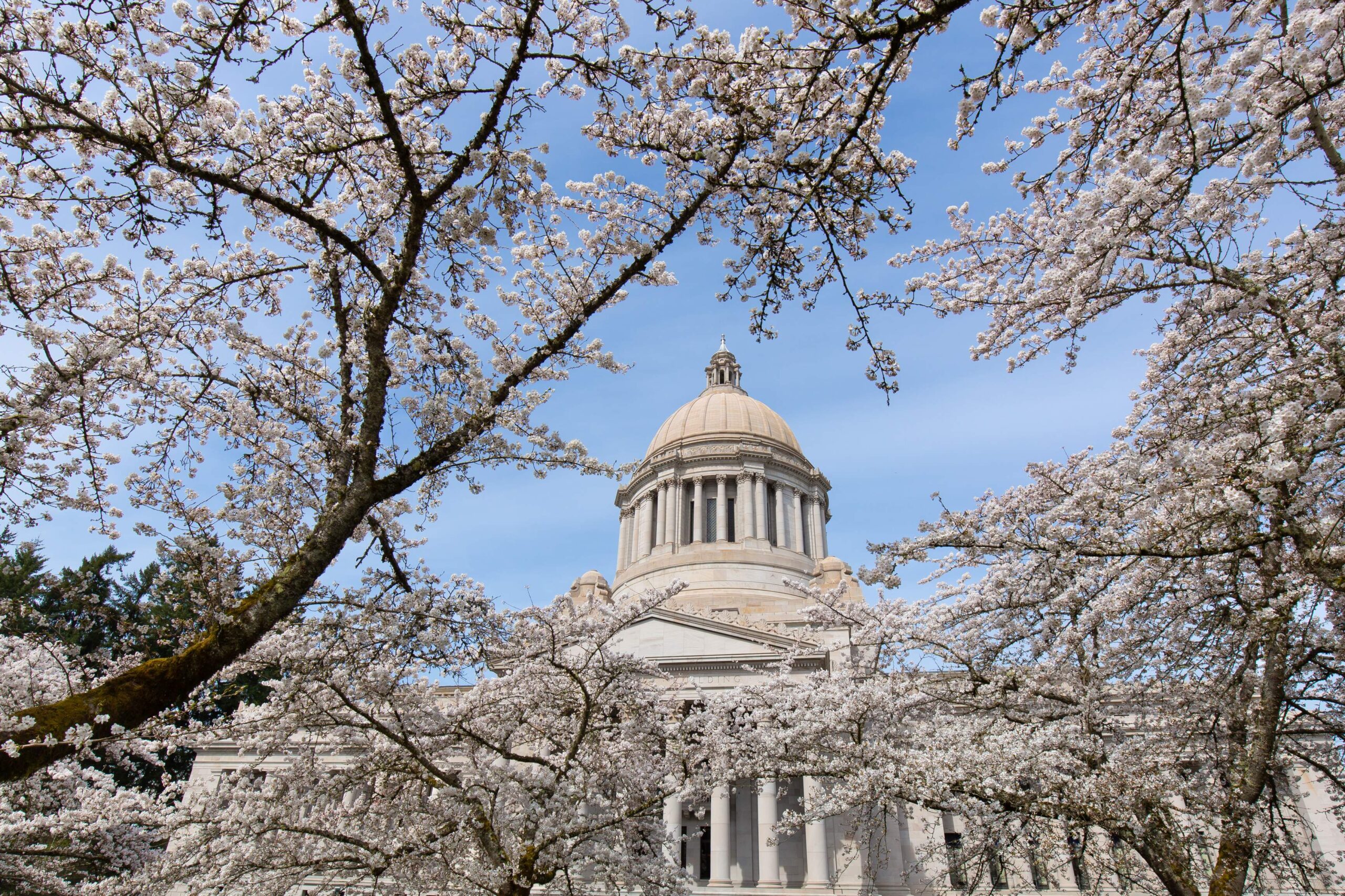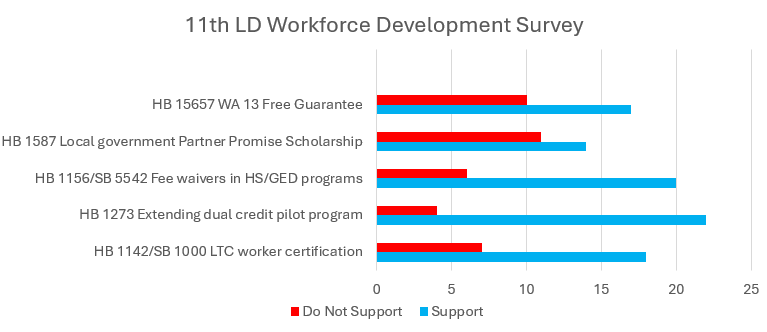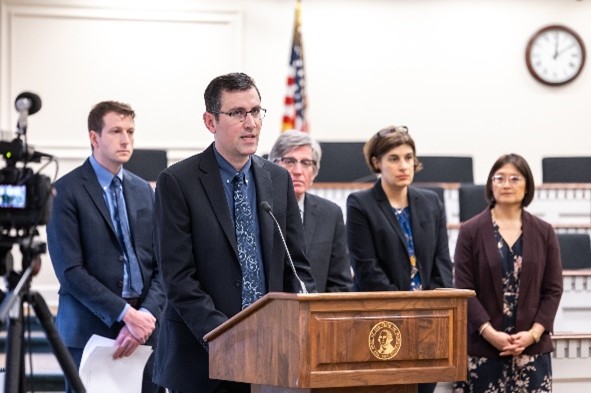Friends and neighbors,
As we enter April, we’re entering the final stretch of the legislative session with just 26 days left until sine-die. This has been a productive time in Olympia, with numerous meetings, discussions on a fair budget, and the arrival of spring. I hope you’re finding time to enjoy Washington’s natural beauty and get outside this month!

This newsletter includes key updates on the results of our workforce development survey, an overview of the biennial operating and transportation budget proposals, and the revenue components within these budgets. I’m always eager to hear your thoughts as we work together.
Workforce Development Survey Results
In a previous newsletter, I discussed workforce shortages affecting critical sectors, including healthcare, public safety, and skilled trades. While we’ve made strides in expanding financial aid and apprenticeships, there’s more to be done to ensure workers can access training and secure good-paying jobs locally.
Thank you to everyone who participated in the workforce development survey. Your responses highlighted workforce shortages in healthcare, public safety, government services, and skilled trades. The sectors where respondents sought the most workforce support include public safety, healthcare, mental health services, and K-12 education.
The most popular strategies for addressing workforce shortages included expanding vocational training, increasing apprenticeships and on-the-job training programs, making childcare more affordable, and offering tax incentives to businesses investing in workforce development. There was also strong support for policy proposals such as standardizing long-term care worker certification, expanding dual-credit program access, and improving financial aid and college opportunities.

As we prepare for the 2025-27 biennial budgets, I encourage you to participate in this week’s survey to share your thoughts on additional proposed revenue measures. It’s vital that we balance our budget deficit while protecting vulnerable populations and not overburdening working families.
A Responsible Budget
As a member of the House Appropriations Committee, my focus remains on crafting a budget that prioritizes vulnerable communities while meeting our constitutional obligation to pass a balanced budget. We face significant economic challenges—rising inflation, federal cuts, and an outdated tax system—that require us to make difficult decisions. Nevertheless, we are committed to ensuring that critical services remain intact without placing undue strain on those least able to bear it.
 To mitigate the impact on vulnerable communities, the House Democratic proposal maintains full funding for essential housing and food assistance programs. This includes $117 million to keep shelter beds available and $93 million for emergency food programs at pandemic-era levels. We will continue funding the Senior Nutrition Program, ensuring more than 13,000 seniors have access to nutritious meals.
To mitigate the impact on vulnerable communities, the House Democratic proposal maintains full funding for essential housing and food assistance programs. This includes $117 million to keep shelter beds available and $93 million for emergency food programs at pandemic-era levels. We will continue funding the Senior Nutrition Program, ensuring more than 13,000 seniors have access to nutritious meals.
Education and public safety are also top priorities. Teacher salaries won’t be reduced, and we’re maintaining support for school meals and special education funding. We’re investing $50 million in local public safety programs, while ensuring reentry and crime victim support services remain funded.
Some program expansions, such as Working Connections Child Care and elements of the Fair Start for Kids Act, have been delayed, but these decisions were made to protect existing services and set these programs up for future success.
Revenue Proposals
 To balance the budget and meet our revenue needs, the House budget proposal introduces reforms for fairness. The Financial Intangible Assets Tax (FIT) ensures the wealthiest Washingtonians contribute to our economy’s stability, generating $2 billion per year for K-12 education. Additionally, adjustments to property tax growth and business surcharges would generate necessary funding without overburdening working families, expected to generate $200 million and $2 billion by 2027, respectively.
To balance the budget and meet our revenue needs, the House budget proposal introduces reforms for fairness. The Financial Intangible Assets Tax (FIT) ensures the wealthiest Washingtonians contribute to our economy’s stability, generating $2 billion per year for K-12 education. Additionally, adjustments to property tax growth and business surcharges would generate necessary funding without overburdening working families, expected to generate $200 million and $2 billion by 2027, respectively.
The Senate Democrats’ proposal has key changes including adjusting the property tax cap to allow annual increases based on population growth plus inflation, rather than the current 1% limit, generating an estimated $779 million over four years. It also includes a new business tax on large employers, requiring a 5% tax on payroll expenses over the Social Security wage threshold, which is expected to raise $2.3 billion annually starting in 2026. A wealth tax would apply to individuals with over $50 million in financial assets, raising $4 billion annually. To reduce the burden on consumers, the state sales tax would drop from 6.5% to 6% in 2027, cutting state revenue by $1.3 billion annually. The plan also includes repealing 20 tax exemptions, projected to bring in $1 billion.
Transportation Budget Proposals
The proposed House 2025-27 Transportation Budget addresses a significant shortfall due to decreased fuel tax revenues and rising construction costs. Fuel taxes, which make up 22% of the budget, are expected to decline by $250 million during the biennium. To mitigate this, the budget makes reductions across highway, local, and multimodal spending but prioritizes key investments like preserving existing infrastructure, safety initiatives, and ferry system improvements.
The House proposal includes $1.8 billion for highway improvements, though some new projects have been delayed such as the 42nd Ave. bridge in Tukwila, which received full funding in the proposed. Senate Transportation budget. It also maintains $455 million for local projects and $1.6 billion for preservation and maintenance. For ferries, investments include hybrid vessel procurement and electrification, with $558 million for public transit and decarbonization efforts. Additionally, $1.3 billion from the Climate Commitment Act will fund clean energy and emissions reduction projects.
As gas tax revenues decline due to more fuel-efficient and electric vehicles, lawmakers are considering alternative revenue sources. A key proposal is the Road Usage Charge (RUC) system, which would charge drivers 2.6 cents per mile, starting in 2027. This would provide a sustainable way to fund transportation long term. The transition to RUC would be phased in, initially including electric and hybrid vehicles voluntarily and eventually extending to all fuel-efficient vehicles. This system would help offset the expected decline in gas tax revenue by over 70% by 2050.
Both House and Senate transportation budgets include measures like new fees on electric vehicle registrations, a surcharge on luxury vehicles, and a tax on rental cars. The House plan includes a $1 billion reserve fund to account for unpredictable cost increases, while the Senate budget sets aside $500 million. The Senate also includes 13 furlough days for state transportation workers, while the House avoids this.
Remembering Speaker Frank Chopp

With a heavy heart, I share the passing of Speaker Frank Chopp, a towering figure in our legislature. Frank’s leadership touched all corners of Washington, and I had the privilege of working with him for 12 years. His commitment to everyday people, regardless of background, and his belief in “One Washington” shaped our state for the better. Washington is better because of his legacy, and I’m grateful for his work and friendship.
Final Thoughts
As always, I value hearing from you. Please share your thoughts or concerns with me, either by phone or email. Thank you for taking the time to read this update. It’s an honor to represent the 11th Legislative District, and I look forward to continuing our work together throughout this session.
Sincerely,

Rep. Steve Bergquist

